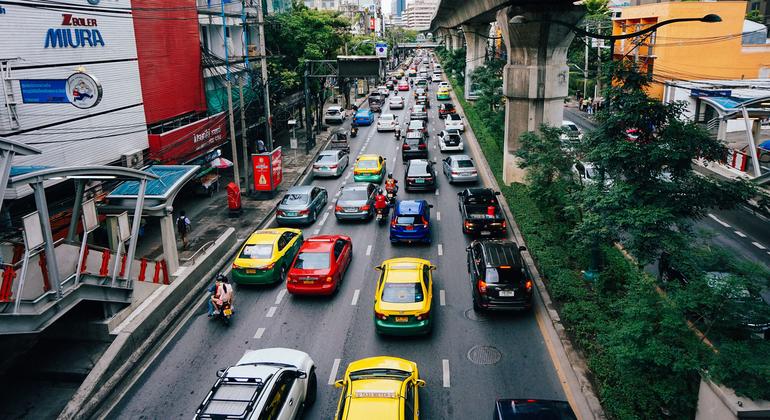“Today’s meeting…is a key opportunity and platform for us to make the changes needed: To strengthen political will, scale up investment, and draw on lessons learned,” said Abdulla Shahid.
It also acts to accelerate action on the Global Plan for the Decade of Action on Road Safety, which kicked off last year, he added.
Enough is enough
After observing a moment of silence for those killed or seriously injured on roads around the world, Mr. Shahid spelled out that “daunting and disturbing” statistics on road safety “can…[and] must change,” describing the meeting as “one step” towards that end.
He said he had five key messages on the issue, first, that “no deaths on our streets are acceptable”.
“Road safety falls under the umbrella of the universal right to health,” for which “safety is paramount”.
Secondly the Assembly President said the Global Plan was “key to reducing deaths and boosting development,” adding that safe systems must be “front and centre” in organizing, designing and building good road systems.
He said the High-Level Meeting itself on road safety, had the potential to “mark a critical juncture” in reducing deaths, and added that it was crucial for governments to implement the Global Plan’s recommendations, including by setting national and sub-national reduction targets; outlining detailed plans for action; and ensuring sustainable financing.
Stressing the significance of transformative leadership, his fourth point was to stress that road safety should be made a political priority “at the highest levels of government”.
Finally, he said, “everyone has a role to play”.
“From urban planners, to engineers, and academia, to civil society,” each person must accept their responsibilities. And mechanisms should be put in place to support them, such as in designing and maintaining roads, manufacturing vehicles, and administering safety programmes.
“The time for action from governments, societies and communities is now”, he said.
“Safe mobility systems offer the promise of a safer, healthier and better future for everyone, everywhere. Let us seize this opportunity”, he concluded.
Development quagmire
Secretary-General António Guterres reminded that road fatalities are closely linked to poor infrastructure, unplanned urbanization, lax healthcare systems, and persistent inequalities both within and between countries.
At the same time, unsafe roads are a key obstacle to development.
“Traffic accidents can push entire families into poverty through either the loss of a breadwinner or the costs associated with lost income and prolonged medical care,” he said.
“Safer roads promote sustainable development”.
Clear-cut goals
The UN chief underscored the goals of a political declaration adopted at the meeting, namely to halve road traffic deaths and injuries by 2030 and promote sustainable mobility “with safety at its core”.
“We need more ambitious and urgent action to reduce the biggest risks – such as speeding; driving under the influence of alcohol or any psychoactive substance or drug; failure to use seatbelts, helmets and child restraints; unsafe road infrastructure and unsafe vehicles: poor pedestrian safety, and inadequate enforcement of traffic laws,” he said.
Mr. Guterres emphasized the need for increased financing for “sustainable and safe infrastructure” and investments in cleaner mobility and greener urban planning, “especially in low and middle-income countries”.
Holistic approach to road safety
From education, health, and transport to climate mitigation, land-use planning, and disaster response, road safety must be integrated in national policies.
The UN chief encouraged all Member States to accede to UN road safety conventions and implement “whole-of-society action plans,” with a “strong prevention approach”.
He also urged donors to scale up much-needed financial and technical contributions through the UN Road Safety Fund.
“Together, we can save lives, support development, and steer our world to safer roads ahead, leaving no one behind,” said the UN chief.
Dangerous transportation
Tedros Adhanom Ghebreyesus, Director-General of the World Health Organization (WHO), reminded that road safety affects everyone.
“We step from our homes every day onto roads that take us to our jobs, schools and to meet our vital daily needs. Yet our transport systems remain far too dangerous,” he said.
“The future of mobility should promote health and well-being, protect the environment and benefit all.”
Making safe roads a reality
Worldwide, road crashes currently kill more than two people every minute. And since the advent of the automobile, more than 50 million fatalities have occurred on the world’s roads – exceeding the number of deaths in the First World War or in some of the worst global epidemics, according to WHO.
In welcoming the newly adopted political declaration, the UN health agency chief recapped that it would require “transformative leadership from the highest levels of government” to turn its vision into reality.
“Putting safety at the heart of our mobility systems is an urgent health, economic and moral imperative,” said Etienne Krug, WHO Director of the Department for Social Determinants of Health. Let’s work together to scale up what works, save lives and build streets for life”.





